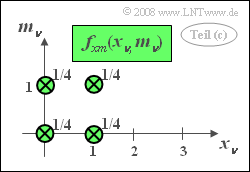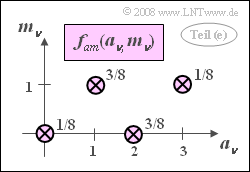Difference between revisions of "Aufgaben:Exercise 4.3: Algebraic and Modulo Sum"
From LNTwww
m (Text replacement - "„" to """) |
|||
| (8 intermediate revisions by 2 users not shown) | |||
| Line 1: | Line 1: | ||
| − | {{quiz-Header|Buchseite= | + | {{quiz-Header|Buchseite=Theory_of_Stochastic_Signals/Two-Dimensional_Random_Variables |
}} | }} | ||
| − | [[File: | + | [[File:EN_Sto_A_4_3_neu2.png|right|frame|Algebraic & modulo–2 sum]] |
| − | |||
| − | |||
| − | |||
| + | [[File:P_ID254__Sto_A_4_3Tab.png|right|frame|Table for moment calculation]] | ||
| + | A "clocked" random number generator returns a sequence $\langle x_\nu \rangle$ of binary random numbers. | ||
| + | *It is assumed that the binary numbers $0$ and $1$ occur with equal probabilities and that the individual random numbers do not depend on each other. | ||
| + | *The random numbers $ x_\nu \in \{0, 1\}$ are entered into the first memory location of a shift register and shifted down one digit with each clock pulse. | ||
| − | |||
| − | + | Two new random sequences $\langle a_\nu \rangle$ and $\langle m_\nu \rangle$ are formed from the contents of the three-digit shift register. Here denotes: | |
| + | |||
| + | * the "algebraic sum" $a_\nu$: | ||
:$$a_\nu=x_\nu+x_{\nu-1}+x_{\nu-2},$$ | :$$a_\nu=x_\nu+x_{\nu-1}+x_{\nu-2},$$ | ||
| − | *$m_\nu$ | + | *the "modulo–2 sum" $m_\nu$: |
:$$m_\nu=x_\nu\oplus x_{\nu-1}\oplus x_{\nu-2}.$$ | :$$m_\nu=x_\nu\oplus x_{\nu-1}\oplus x_{\nu-2}.$$ | ||
| − | |||
| − | |||
<br><br><br><br><br><br> | <br><br><br><br><br><br> | ||
| − | + | Hints: | |
| − | <br clear=all> | + | *This exercise belongs to the chapter [[Theory_of_Stochastic_Signals/Two-Dimensional_Random_Variables|Two-Dimensional Random Variables]]. |
| − | === | + | *Use the following table for moment calculation. |
| + | <br clear=all> | ||
| + | ===Questions=== | ||
<quiz display=simple> | <quiz display=simple> | ||
| − | { | + | {Calculate the probabilities of the random variable $m_\nu$. What is the probability that the modulo-2 sum is equal to $0$ ? |
|type="{}"} | |type="{}"} | ||
| − | ${\rm Pr}(m_\nu = 0) \ = \ $ | + | ${\rm Pr}(m_\nu = 0) \ = \ $ { 0.5 3% } |
| − | { | + | {Are there statistical dependencies within the sequence $\langle m_\nu \rangle$? |
|type="()"} | |type="()"} | ||
| − | + | + | + The sequence elements $m_\nu$ are statistically independent. |
| − | - | + | - There are statistical bindings within the sequence $\langle m_\nu \rangle$. |
| − | { | + | {Determine the 2D–PDF $f_{xm}(x_\nu, m_\nu)$. Based on the result, evaluate the following statements. |
|type="[]"} | |type="[]"} | ||
| − | - | + | - The random variables $x_\nu$ and $m_\nu$ are statistically dependent. |
| − | + | + | + The random variables $x_\nu$ and $m_\nu$ are statistically independent. |
| − | - | + | - The random variables $x_\nu$ and $m_\nu$ are correlated. |
| − | + | + | + The random variables $x_\nu$ and $m_\nu$ are uncorrelated. |
| − | { | + | {Do statistical dependencies exist within the sequence $\langle a_\nu \rangle$ ? |
|type="()"} | |type="()"} | ||
| − | - | + | - The sequence elements $a_\nu$ are statistically independent. |
| − | + | + | + There are statistical bindings within the sequence $\langle a_\nu \rangle$. |
| − | { | + | {Determine the 2D–PDF $f_{am}(a_\nu, m_\nu)$ and the correlation coefficient $\rho_{am}$. Which of the following statements are true? |
|type="[]"} | |type="[]"} | ||
| − | + | + | + The random variables $a_\nu$ and $m_\nu$ are statistically dependent. |
| − | - | + | - The random variables $a_\nu$ and $m_\nu$ are statistically independent. |
| − | - | + | - The random variables $a_\nu$ and $m_\nu$ are correlated. |
| − | + | + | + The random variables $a_\nu$ and $m_\nu$ are uncorrelated. |
| Line 62: | Line 64: | ||
</quiz> | </quiz> | ||
| − | === | + | ===Solution=== |
{{ML-Kopf}} | {{ML-Kopf}} | ||
| − | '''(1)''' | + | '''(1)''' It can be seen from the table in the information section that for the modulo–2 sum, the two values $0$ and $1$ have equal probability: |
:$${\rm Pr}(m_\nu = 0) = {\rm Pr}(m_\nu = 1)\hspace{0.15cm}\underline{=0.5}.$$ | :$${\rm Pr}(m_\nu = 0) = {\rm Pr}(m_\nu = 1)\hspace{0.15cm}\underline{=0.5}.$$ | ||
| − | '''(2)''' | + | '''(2)''' The table shows that for each preassignment ⇒ $( x_{\nu-1}, x_{\nu-2}) = (0,0), (0,1), (1,0), (1,1)$, the values $m_\nu = 0$ and $m_\nu = 1$ resp. are equally likely. |
| − | * | + | *Expressed differently: ${\rm Pr}(m_{\nu}\hspace{0.05cm}|\hspace{0.05cm}m_{\nu-1}) = {\rm Pr}( m_{\nu}).$ |
| − | * | + | *This exactly matches the definition of "statistical independence" ⇒ <u>Answer 1</u>. |
| − | [[File:P_ID224__Sto_A_4_3_c.png|right|frame|2D | + | [[File:P_ID224__Sto_A_4_3_c.png|right|frame|2D–PDF of $x$ and $m$]] |
| − | '''(3)''' | + | '''(3)''' Correct are <u>the second and the last suggested solutions</u>. |
| − | * | + | *The 2D–PDF consists of four Dirac delta functions, each with weight $1/4$. |
| − | * | + | *One obtains this result, for example, by evaluating the table in the data section. |
| − | * | + | *Since $f_{xm}(x_\nu, m_\nu)=f_{x}(x_\nu) \cdot f_{m}(m_\nu)$, the quantities $x_\nu$ and $m_\nu$ are statistically independent. |
| − | * | + | *Statistically independent random variables, however, are also linearly statistically independent, so they are certainly uncorrelated. |
| − | '''(4)''' | + | '''(4)''' Within the sequence $\langle a_\nu \rangle$ of algebraic sum there are statistical bindings ⇒ <u>Answer 2</u>. |
| − | * | + | *You can see this because the unconditional probability is $ {\rm Pr}( a_{\nu} = 0) =1/8$, |
| − | * | + | *while, for example, ${\rm Pr}(a_{\nu} = 0\hspace{0.05cm}|\hspace{0.05cm}a_{\nu-1} = 3) =0$ holds. |
| − | [[File:P_ID225__Sto_A_4_3_e.png|right|frame|2D | + | [[File:P_ID225__Sto_A_4_3_e.png|right|frame|2D–PDF of $a$ and $m$]] |
| − | '''(5)''' | + | '''(5)''' Correct are <u>the first and the last suggested solutions</u>: |
| − | * | + | *As in the subtask '''(3)''' there are again four Dirac delta functions, but this time not with equal Dirac weights $1/4$. |
| − | * | + | *The two-dimensional PDF thus cannot be written as a product of the two marginal probability densities. |
| − | * | + | *But this means that statistical bindings must exist between $a_\nu$ and $m_\nu$. |
| − | * | + | *For the joint expected value, one obtains: |
:$${\rm E}\big[a\cdot m \big] = \rm \frac{1}{8}\cdot 0 \cdot 0 +\frac{3}{8}\cdot 2 \cdot 0 +\frac{3}{8}\cdot 1 \cdot 1 + \frac{1}{8}\cdot 3 \cdot 1 = \frac{3}{4}.$$ | :$${\rm E}\big[a\cdot m \big] = \rm \frac{1}{8}\cdot 0 \cdot 0 +\frac{3}{8}\cdot 2 \cdot 0 +\frac{3}{8}\cdot 1 \cdot 1 + \frac{1}{8}\cdot 3 \cdot 1 = \frac{3}{4}.$$ | ||
| − | * | + | *With the linear means ${\rm E}\big[a \big] = 1.5$ and ${\rm E}[m] = 0.5$ it follows for the covariance: |
:$$\mu_{am}= {\rm E}\big[ a\cdot m \big] - {\rm E}\big[ a \big]\cdot {\rm E} \big[ m \big] = \rm 0.75-1.5\cdot 0.5 = \rm 0.$$ | :$$\mu_{am}= {\rm E}\big[ a\cdot m \big] - {\rm E}\big[ a \big]\cdot {\rm E} \big[ m \big] = \rm 0.75-1.5\cdot 0.5 = \rm 0.$$ | ||
| − | * | + | *Thus, the correlation coefficient $\rho_{am}= 0$. That is: The dependencies present are nonlinear. |
| − | * | + | *The quantities $a_\nu$ and $m_\nu$ are statistically dependent, but still uncorrelated. |
{{ML-Fuß}} | {{ML-Fuß}} | ||
| − | [[Category:Theory of Stochastic Signals: Exercises|^4.1 | + | [[Category:Theory of Stochastic Signals: Exercises|^4.1 Two-Dimensional Random Variables^]] |
Latest revision as of 14:49, 17 November 2022
A "clocked" random number generator returns a sequence $\langle x_\nu \rangle$ of binary random numbers.
- It is assumed that the binary numbers $0$ and $1$ occur with equal probabilities and that the individual random numbers do not depend on each other.
- The random numbers $ x_\nu \in \{0, 1\}$ are entered into the first memory location of a shift register and shifted down one digit with each clock pulse.
Two new random sequences $\langle a_\nu \rangle$ and $\langle m_\nu \rangle$ are formed from the contents of the three-digit shift register. Here denotes:
- the "algebraic sum" $a_\nu$:
- $$a_\nu=x_\nu+x_{\nu-1}+x_{\nu-2},$$
- the "modulo–2 sum" $m_\nu$:
- $$m_\nu=x_\nu\oplus x_{\nu-1}\oplus x_{\nu-2}.$$
Hints:
- This exercise belongs to the chapter Two-Dimensional Random Variables.
- Use the following table for moment calculation.
Questions
Solution
(1) It can be seen from the table in the information section that for the modulo–2 sum, the two values $0$ and $1$ have equal probability:
- $${\rm Pr}(m_\nu = 0) = {\rm Pr}(m_\nu = 1)\hspace{0.15cm}\underline{=0.5}.$$
(2) The table shows that for each preassignment ⇒ $( x_{\nu-1}, x_{\nu-2}) = (0,0), (0,1), (1,0), (1,1)$, the values $m_\nu = 0$ and $m_\nu = 1$ resp. are equally likely.
- Expressed differently: ${\rm Pr}(m_{\nu}\hspace{0.05cm}|\hspace{0.05cm}m_{\nu-1}) = {\rm Pr}( m_{\nu}).$
- This exactly matches the definition of "statistical independence" ⇒ Answer 1.
(3) Correct are the second and the last suggested solutions.
- The 2D–PDF consists of four Dirac delta functions, each with weight $1/4$.
- One obtains this result, for example, by evaluating the table in the data section.
- Since $f_{xm}(x_\nu, m_\nu)=f_{x}(x_\nu) \cdot f_{m}(m_\nu)$, the quantities $x_\nu$ and $m_\nu$ are statistically independent.
- Statistically independent random variables, however, are also linearly statistically independent, so they are certainly uncorrelated.
(4) Within the sequence $\langle a_\nu \rangle$ of algebraic sum there are statistical bindings ⇒ Answer 2.
- You can see this because the unconditional probability is $ {\rm Pr}( a_{\nu} = 0) =1/8$,
- while, for example, ${\rm Pr}(a_{\nu} = 0\hspace{0.05cm}|\hspace{0.05cm}a_{\nu-1} = 3) =0$ holds.
(5) Correct are the first and the last suggested solutions:
- As in the subtask (3) there are again four Dirac delta functions, but this time not with equal Dirac weights $1/4$.
- The two-dimensional PDF thus cannot be written as a product of the two marginal probability densities.
- But this means that statistical bindings must exist between $a_\nu$ and $m_\nu$.
- For the joint expected value, one obtains:
- $${\rm E}\big[a\cdot m \big] = \rm \frac{1}{8}\cdot 0 \cdot 0 +\frac{3}{8}\cdot 2 \cdot 0 +\frac{3}{8}\cdot 1 \cdot 1 + \frac{1}{8}\cdot 3 \cdot 1 = \frac{3}{4}.$$
- With the linear means ${\rm E}\big[a \big] = 1.5$ and ${\rm E}[m] = 0.5$ it follows for the covariance:
- $$\mu_{am}= {\rm E}\big[ a\cdot m \big] - {\rm E}\big[ a \big]\cdot {\rm E} \big[ m \big] = \rm 0.75-1.5\cdot 0.5 = \rm 0.$$
- Thus, the correlation coefficient $\rho_{am}= 0$. That is: The dependencies present are nonlinear.
- The quantities $a_\nu$ and $m_\nu$ are statistically dependent, but still uncorrelated.



